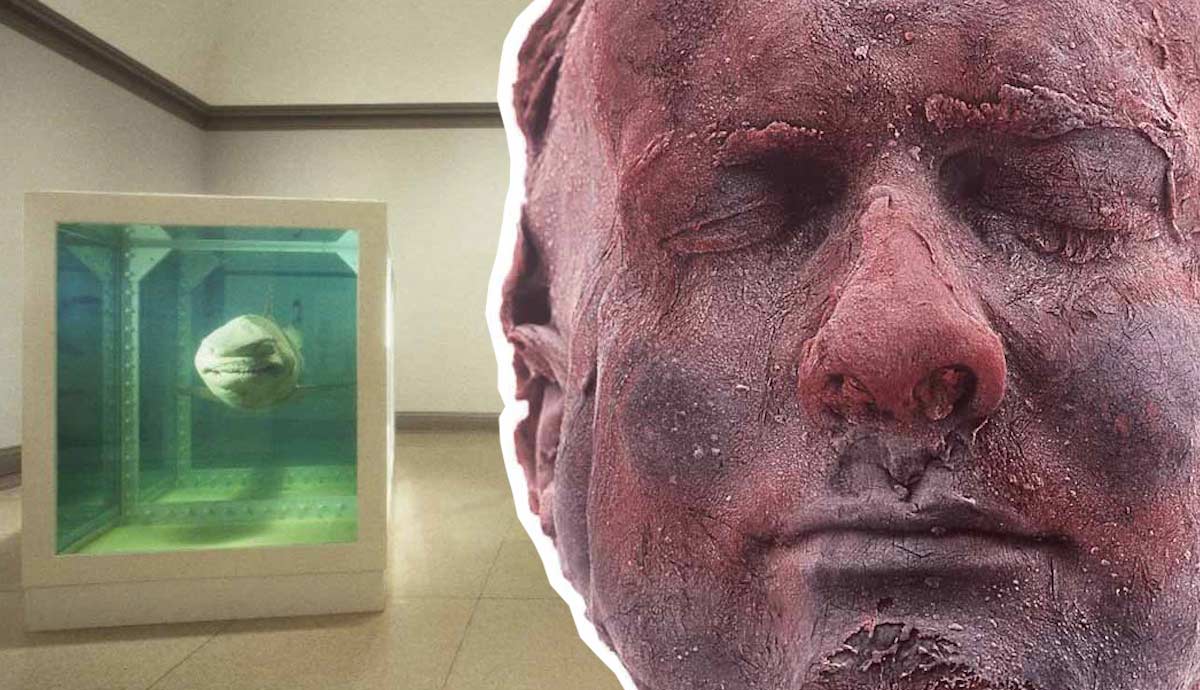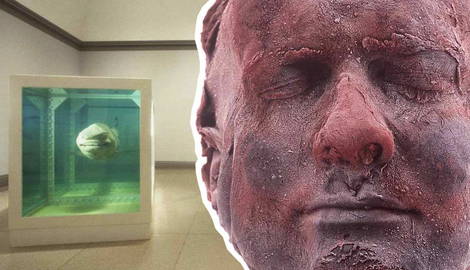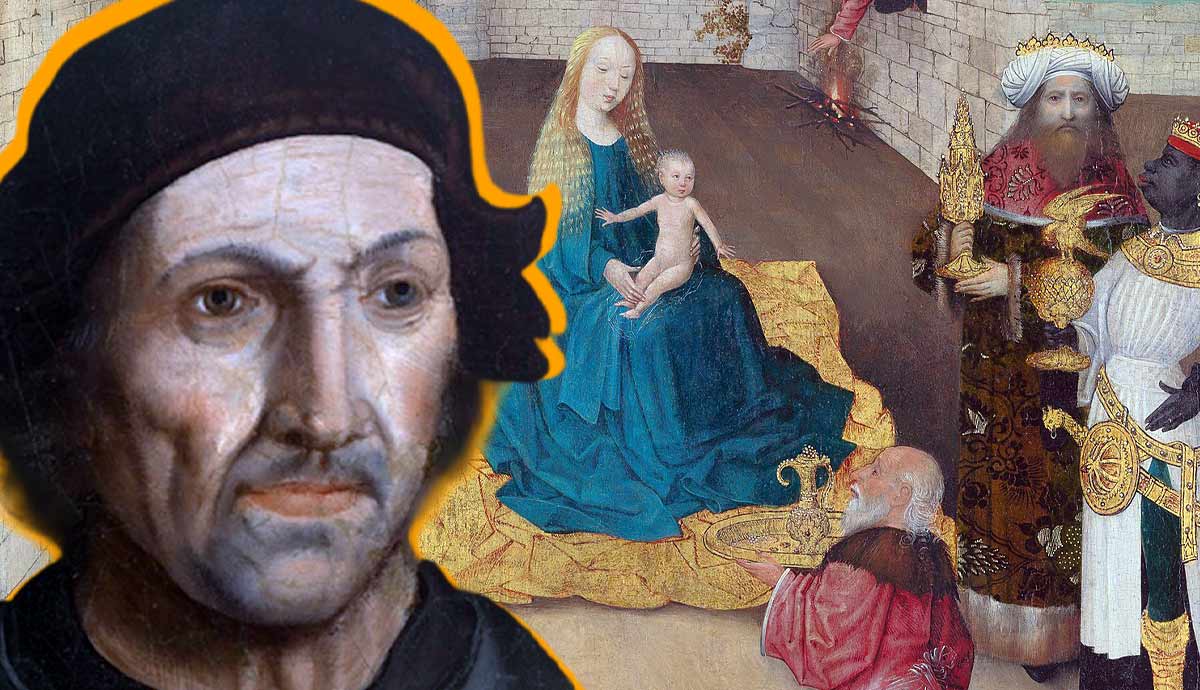
In 1988, a group of art students from London’s Goldsmiths College united to exhibit their art together. Their techniques, mediums, and ideas were different, but they all shared a deeply polarizing attitude toward art with an entrepreneurial approach. The versatile and multifaceted YBAs are often regarded as controversial, with their unconventional materials and sometimes repulsive topics unacceptable to some. Read on to learn more about the Young British Artists and their art.
Young British Artists: Origins and Characteristics

The Young British Artists, also known as YBAs, were a loose group of art students sharing one exhibition space. The history of the group started in 1988, when a second-year student of Goldsmiths College Damien Hirst organized a show titled Freeze. This exhibit brought together recent alumni and current students. They shared neither techniques nor ideologies but rather a sense of current time and place, originating from a single cultural strata. Despite major art galleries initially ignoring Hirst’s initiative, he managed to find private sponsors and soon attracted the attention of art collectors. The most famous names of the YBA include Damien Hirst, Sarah Lucas, Fiona Rae, Rachel Whiteread, and many other artists who started their careers in Britain in the late 1980s.

The event that defined the emergence of the YBA was a show titled Sensation, which traveled through European and American museums in the late 1990s, cementing the new cultural phenomenon in public minds. Gone was the original attitude of a show curated by artists on their own terms: Sensation was a carefully orchestrated event arranged by a professional from the advertising industry called Charles Saatchi, who conveniently owned all pieces on display. The catchy acronym YBA started to appear in press releases and news articles, mostly concerning offensive pieces of art on display.
Among the most dramatic pieces was the portrait of a serial child killer Myra Hindley, made by the artist Marcus Harvey from hundreds of children’s handprints. There was also the famous installation by Tracey Emin titled Everyone I Have Ever Slept With. The critics chose to interpret the tent with embroidered names as a marker of Emin’s promiscuity and exhibitionism. However, the work related much more to the general concept of intimacy, with some names referring to Emin’s grandmother, twin brother, and childhood friends, and not just to lovers. As a result, the contradicting press coverage and the constant undertone of scandal only fueled the public’s interest in the show, making it the main cultural event of the year.
Who Is Charles Saatchi?

Charles Saatchi, the Iraqi-British businessman and art collector, is the person directly responsible for the emergence of YBAs as a group. At the age of just seventeen, he moved to the US and started to work as a copywriter in advertising agencies, soon opening his own business and taking many wealthy clients with him. Saatchi started to collect art in 1969 while in his mid-twenties. Initially, he preferred Minimalism which was safe and trendy in the field of high-end collectors and white cube galleries.
In 1990, he got familiar with the works of the Goldsmiths College art students, immediately purchasing some of their works. Soon, Saatchi started to actively develop the brand of YBA, simultaneously buying their works while they were still relatively inexpensive. Art critics still argue whether it was a personal passion or an ambitious financial project that turned into a great success. Saatchi deliberately chose the most shocking and provocative pieces from every artist’s oeuvre and positioned himself as their generous patron who discovered his proteges years ago despite only purchasing their works recently. The early Saatchi exhibitions brought almost immediate stardom to many creatives represented, yet not all of them were happy about it. Artist Gavin Turk deliberately attended the Sensation show dressed as a homeless beggar. He felt like the show was not about the art but rather about the collector’s ego and his market machinations.

However, the patron’s relationship with his protegees had an expiration date. In 2012, Saatchi had a thinly concealed conflict with Damien Hirst that resulted in the collector threatening to put all of Hirst’s work from the Saatchi collection back on the market. To avoid the rapid depreciation of his existing works, Hirst was forced to repurchase his artworks directly from Saatchi, greatly overpaying for them. The list of works included the famous A Thousand Years, an installation featuring a rotting cow’s head and a fly zapper. According to the rumors, the reason for such an abrupt breakup was Hirst’s refusal to participate in his own retrospective, organized by Charles Saatchi, due to the over-commercialization of his art. In his interviews, Hirst repeatedly stated that Saatchi was capable of recognizing art only with his wallet.
YBA & Shock Value: Blood, Dung, and Scandal

Today, the Young British Artists remain one of the most influential yet loose groups of artists in the contemporary art world. However, they also draw significant criticism for their subject matter and approach to presentation. Many of the YBAs were accused of using shock value just for the sake of it, minimizing the artistic component of their works. Apart from Damien Hirst using dead animals for his installations, other YBAs often experiment with materials regarded as shocking and repulsive.
The YBA Marc Quinn became notorious for creating a series of sculptures titled Self from his own frozen blood. Every five years, Quinn collects ten pints of his blood and freezes them in a mold made from his head. The series represents Quinn’s battle against alcohol addiction as well as questions of identity and existence, with the artist’s portrait made from the artist’s body. However, many viewers found the use of such material repulsive and gross. According to rumors from the early 2000s, the first cast of Quinn’s head, bought by Charles Saatchi, was accidentally destroyed during construction works in his house. Allegedly, the collector was storing the bust in his kitchen freezer, which the workers unplugged while fixing kitchen appliances.

In 1999, a painting by Chris Ofili caused immense outrage during an exhibition at the Brooklyn Museum. The Holy Virgin Mary, also called a hip-hop Madonna by the artist, featured a Black woman dressed in blue (the traditional color for the Virgin Mary’s robe), surrounded by what appear to be floral ornaments. Under closer inspection, the ornaments turn out to be close-up images of female genitalia.
However, the most scandalous part of it was Ofili’s decision to use elephant dung along with paint to create his image. With this material, the artist referenced the traditional culture of the Mozambique region, where locals use elephant dung to build houses, cure diseases, and fertilize soil. The substance, repulsive to Westerners, provides locals with comfort and safety. Ofili aimed to create an image of a Black Madonna that would be familiar and deeply symbolic for African and African American audiences. However, the New York public and the city mayor Rudolph Giuliani did not understand the reference and felt deeply offended. On several occasions, visitors attempted to attack and destroy the work, while Giuliani threatened to withdraw funding from the gallery that presented Ofili’s work.
Art as Entrepreneurship: Young British Artists & the Art Market

The YBA generation represented the quintessential capitalist dream of an artist selling questionable and over-intellectualized pieces to the nouveau-riche crowd. Hardly united by a common subject matter or a shared technique, they all have a symbiotic relationship with the art market. This point is particularly visible in the example of the most notorious of the YBAs, Damien Hirst.

In his early years, Hirst openly admitted to wanting to become famous enough to make bad art and get away with it. His artistic outputs include a series of colorful dot paintings created by his numerous assistants, participation in the NFT industry, and short-lived commercial projects like a restaurant based on the aesthetics of his earlier works. The YBA project that started as a commercial enterprise hardly ever overgrew this notion, remaining an expensive toy for rich consumers and an illustration of the market mechanisms.










